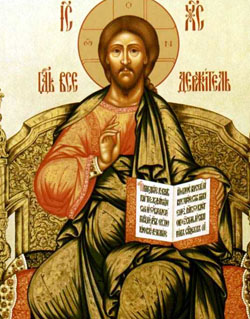December 2009 - Vol. 35
action, and prayer at all times Jesus was born in order to die. Indeed, of all humans who ever lived on earth, God's Son is the only one who entered the world for this purpose. He came to die so that we might live in and through him. The eternal life which he brings to the world is already present and active in those who receive him, but it will be manifested fully and completely in a way which no one can question, doubt, or resist only at the end of the ages. Christians are those who remember and celebrate the fact that God has visited his people in the person of his Son in order to be crucified and raised. And so they are also those who await his Coming, believing that all of God's promises made in and through Jesus will be actualized in the age to come. Therefore they expect nothing here. They want nothing here. They know that they will get nothing here. Their Savior's promise for this age is only persecution and tribulation. Jesus said, "Truly, I say to you, there is no one who has left house or brothers or sisters or mother or father or children or lands, for my sake and for the gospel, who will not receive a hundredfold now in this time, houses and brothers and sisters and mothers and children and lands, with persecutions, and in the age to come eternal life." (Mark 10:29-30)Christians live between the two comings of Christ. They remember his first coming to be sacrificed. They anticipate his second coming to reign. This is vividly portrayed in traditional Orthodox church buildings where the "royal gates" of the icon screen in front of the altar table are flanked by the icons of the Theotokos and Child on the one side, and the Lord Jesus in glory on the other. To the uninitiated it may seem as though these are simply pictures of Mary and Jesus put on the same level. This is not so. The icons which frame the Orthodox altar are images of the two comings of Christ. Mary is not alone in her icon; she is holding the Christ child, who is not shown as a baby, but as the Son of God incarnate "in the form of a slave ... in the likeness of men" (Philippians 2:7). This is the icon of Christ's first coming. And the icon on the right of the doors is not a picture of Jesus as he was on the earth. It is his image in glory as King and Lord, the icon of his second coming. The two comings of Christ are held together in Christian thought, action, and prayer at all times. They cannot be separated. When they are, it is the end of Christian faith, life and worship. The first coming without the second is a meaningless tragedy. The second coming without the first is an absurd impossibility. Jesus is born to bring God's kingdom. He dies to prove his kingship. He rises to establish his reign. He comes again in glory to share it with his people. In the kingdom of God there are no subjects. All rule with the risen Messiah. He came, and is coming, for this purpose alone. You have taken me captive with longing for You, O Christ, 3 This is a pre-Communion prayer in some Orthodox prayer books (e.g., see A Manual of Eastem Orthodox Prayers [London: SPCK, 1945) p. 77 [republished in 1984 by Saint Vladimir's Seminary Press, Crestwood, New York]). It was written by Saint John of Damascus and is originally found in the second canon for matins of the feast of the Transfiguration, August 6, ode 9, troparion 3. [This
article is excerpted from The Winter Pascha: Readings for the Christmas-Epiphany
Season, by Thomas Hopko, © 1984 by St. Vladimirís Seminary Press,
Crestwood, New York 10707. All rights reserved. Used with permission.]
|
. | ||||
|
publishing address: Park Royal Business Centre, 9-17 Park Royal Road, Suite 108, London NW10 7LQ, United Kingdom email: living.bulwark@yahoo.com |
. |
